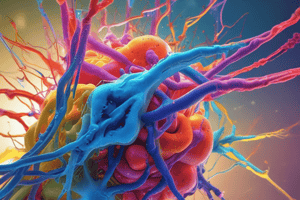Podcast
Questions and Answers
Which of the following statements accurately describes the role of myelination in conduction velocity?
Which of the following statements accurately describes the role of myelination in conduction velocity?
- Myelination allows the action potential to jump between nodes, increasing speed. (correct)
- Myelination only affects the conduction velocity of Group C fibers.
- Myelination reduces the need for voltage-gated Na+ channels along the entire axon.
- Myelination increases conduction velocity by allowing continuous conduction.
How does the diameter of nerve fibers affect their conduction velocity?
How does the diameter of nerve fibers affect their conduction velocity?
- Larger diameter fibers transmit impulses faster than smaller ones due to reduced resistance. (correct)
- Larger diameter fibers have slower conduction velocities than smaller ones.
- Conduction velocity is independent of the diameter of nerve fibers.
- Only myelinated fibers show a correlation between diameter and conduction velocity.
What clinical symptoms may indicate impaired action potential propagation?
What clinical symptoms may indicate impaired action potential propagation?
- Improved muscular coordination and clarity of speech
- Visual disturbances, weakness, and loss of muscular control (correct)
- Increased sensory perception in visceral organs
- Enhanced reaction times during physical activity
What is the primary effect of local anesthetics on action potentials?
What is the primary effect of local anesthetics on action potentials?
Which of the following fibers would be expected to transmit action potentials at the slowest rate?
Which of the following fibers would be expected to transmit action potentials at the slowest rate?
What happens to the membrane potential during hyperpolarization?
What happens to the membrane potential during hyperpolarization?
Which statement accurately describes the nature of graded potentials?
Which statement accurately describes the nature of graded potentials?
What triggers the generation of graded potentials in neurons?
What triggers the generation of graded potentials in neurons?
How do action potentials differ from graded potentials?
How do action potentials differ from graded potentials?
In what specific locations do action potentials primarily occur?
In what specific locations do action potentials primarily occur?
Which of the following options correctly describes the factors influencing the spread of graded potentials?
Which of the following options correctly describes the factors influencing the spread of graded potentials?
What change in ion concentration typically occurs during depolarization?
What change in ion concentration typically occurs during depolarization?
What effect does hyperpolarization have on a neuron's ability to fire an impulse?
What effect does hyperpolarization have on a neuron's ability to fire an impulse?
What primarily resets the electrical conditions after repolarization during an action potential?
What primarily resets the electrical conditions after repolarization during an action potential?
What must occur for an axon to produce an action potential?
What must occur for an axon to produce an action potential?
What characterizes the all-or-none phenomenon of action potentials?
What characterizes the all-or-none phenomenon of action potentials?
How does the propagation of an action potential occur along an unmyelinated axon?
How does the propagation of an action potential occur along an unmyelinated axon?
Which of the following statements about sodium ion influx during an action potential is true?
Which of the following statements about sodium ion influx during an action potential is true?
What happens to sodium channels immediately after an action potential is initiated?
What happens to sodium channels immediately after an action potential is initiated?
What is the consequence of depolarizing the membrane by 15 to 20 mV?
What is the consequence of depolarizing the membrane by 15 to 20 mV?
Which ion is primarily involved in the depolarization phase of an action potential?
Which ion is primarily involved in the depolarization phase of an action potential?
During the action potential propagation in myelinated axons, where does the action potential occur?
During the action potential propagation in myelinated axons, where does the action potential occur?
How does the central nervous system differentiate between a weak and strong stimulus?
How does the central nervous system differentiate between a weak and strong stimulus?
What occurs during the absolute refractory period?
What occurs during the absolute refractory period?
Which of the following best describes the relationship between axon diameter and conduction velocity?
Which of the following best describes the relationship between axon diameter and conduction velocity?
What does the relative refractory period coincide with?
What does the relative refractory period coincide with?
What defines the all-or-none principle in action potentials?
What defines the all-or-none principle in action potentials?
What primarily dictates the conduction velocity of action potentials in neurons?
What primarily dictates the conduction velocity of action potentials in neurons?
Which of the following statements about action potentials is accurate?
Which of the following statements about action potentials is accurate?
What is the main factor that prevents a neuron from responding to a new stimulus during the absolute refractory period?
What is the main factor that prevents a neuron from responding to a new stimulus during the absolute refractory period?
How does the frequency of action potentials relate to the intensity of the stimulus?
How does the frequency of action potentials relate to the intensity of the stimulus?
What phenomenon occurs when the inside of the membrane becomes less negative than the resting membrane potential?
What phenomenon occurs when the inside of the membrane becomes less negative than the resting membrane potential?
Which ions' concentration difference is crucial in generating the resting membrane potential?
Which ions' concentration difference is crucial in generating the resting membrane potential?
What is the expected result of an increase in membrane permeability to Na+ ions?
What is the expected result of an increase in membrane permeability to Na+ ions?
What type of signal is produced when the membrane potential changes over short distances?
What type of signal is produced when the membrane potential changes over short distances?
What ultimately balances the K+ leakage from the cell to establish a negative membrane potential?
What ultimately balances the K+ leakage from the cell to establish a negative membrane potential?
What occurs during hyperpolarization of a membrane?
What occurs during hyperpolarization of a membrane?
In the context of membrane potential changes, what is the role of protein anions?
In the context of membrane potential changes, what is the role of protein anions?
What best describes the relationship between graded potentials and action potentials?
What best describes the relationship between graded potentials and action potentials?
Which statement accurately describes the resting membrane potential?
Which statement accurately describes the resting membrane potential?
What mechanism allows for the generation of action potentials based on membrane permeability changes?
What mechanism allows for the generation of action potentials based on membrane permeability changes?
Study Notes
Membrane Potential Changes
- Membrane potential can change when the ion concentrations across the membrane change or when the membrane permeability to ions changes.
- These changes can produce two types of signals: graded potentials and action potentials.
- Graded potentials are short-lived, localized changes in membrane potential that act over short distances.
- Action potentials are long-distance signals that travel down the axon of a neuron.
Hyperpolarization and Depolarization
- Hyperpolarization is an increase in membrane potential, making the inside of the membrane more negative than the resting membrane potential.
- Hyperpolarization decreases the probability of producing an impulse.
- Depolarization is a decrease in membrane potential, making the inside of the membrane less negative than the resting membrane potential.
- Depolarization increases the probability of producing an impulse.
Graded Potentials
- Graded potentials are triggered by a stimulus that opens gated ion channels, resulting in depolarization or sometimes hyperpolarization.
- The strength of the stimulus determines the magnitude of the voltage change and the distance the current flows.
- Graded potentials decay over short distances.
Action Potentials
- Action potentials are the principle way neurons send signals and are the means of long-distance neural communication in muscles and axons.
- They involve a brief reversal of membrane potential with a change in voltage of approximately 100 mV.
- Action potentials do not decay over distance like graded potentials.
- They involve the opening of specific voltage-gated channels.
Generating an Action Potential
- An action potential is generated when the membrane is depolarized to a threshold voltage.
- The threshold voltage is typically 15-20 mV above the resting membrane potential.
- At threshold, Na+ permeability increases and Na+ influx exceeds K+ efflux, initiating a positive feedback cycle.
All-or-None Phenomenon
- An action potential either happens completely or not at all.
- This is known as the "all-or-none" principle.
Propagation of an Action Potential
- Propagation allows the action potential to be transmitted from its origin down the entire axon length towards the terminals.
- Na+ influx through voltage gates in one membrane area cause local currents that open Na+ voltage gates in adjacent membrane areas.
- This leads to depolarization of that area, which in turn causes depolarization in the next area.
Refractory Periods
- A refractory period is a time when a neuron cannot trigger another action potential.
- Absolute refractory period: No new action potential can be generated during this period, as voltage-gated Na+ channels are open.
- Relative refractory period: Follows the absolute refractory period; most Na+ channels are reset, but a stronger stimulus is required to trigger an action potential.
Conduction Velocity
- The speed of action potential propagation varies depending on the axon diameter and the degree of myelination.
- Axon diameter: Larger diameter axons have less resistance to local current flow and therefore conduct impulses faster.
- Myelination: Myelin sheaths insulate and prevent leakage of charge, making conduction faster.
Types of Nerve Fibers
- Nerve fibers are classified into three groups based on their diameter, degree of myelination, and speed of conduction:
- Group A fibers: Largest diameter, myelinated, transmit at ~300 mph.
- Group B fibers: Medium diameter, lightly myelinated, transmit at ~30 mph
- Group C fibers: Smallest diameter, unmyelinated, transmit at ~2 mph.
Impaired AP Impulse Propagation
- Impaired action potential impulse propagation can be caused by a number of factors like local anesthetics, cold temperatures, or continuous pressure that interrupts blood flow to neurons.
Studying That Suits You
Use AI to generate personalized quizzes and flashcards to suit your learning preferences.
Related Documents
Description
Explore the dynamics of membrane potential changes in neurons. This quiz covers graded and action potentials, along with hyperpolarization and depolarization. Test your knowledge on how these phenomena impact neuronal signaling.




